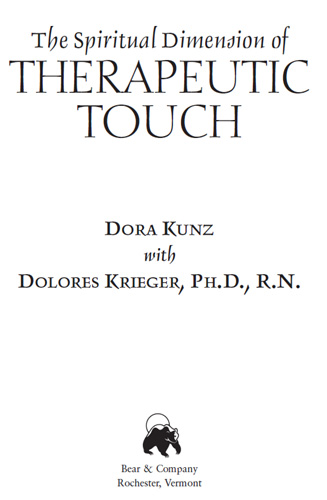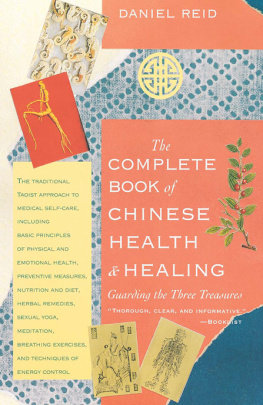
Acknowledgments

The initial idea for The Spiritual Dimension of Therapeutic Touch occurred in the 1990s with the thought that Dora Kunz herself would be writing this book. Other work intervened, however, and after her death I took on what proved to be a profoundly challenging but nevertheless thrilling learning experience. In the course of the project several persons stepped forward to help, and I am most pleased to note my appreciation of them.
Foremost, I would like to cite John Kunz, Doras son, for his willingness to critique the manuscript so that it would reflect an accurate representation of Doras voice and the significance of her work, and to share audio tapes from his personal archives containing Doras own explanation of her unusual perceptual abilities. I am also grateful to both Pumpkin Hollow Foundation and to Orcas Island Foundation for making their audio tape libraries of Doras recordings available to me.
Patricia Abrams shared with me her considerable acumen about the publishing world, and helped me plot out an initial outline. Julie Benofsky-Webb will forever be my heroine in this story because of her dependable and resolute volunteer assumption of the arduous but necessary task of typing the initial manuscript, as well as for providing me with the skills of an expert grammarian and being an astute sounding-board as she listened to my readings of the first draft. This necessitated that she... learn all kinds of new things to accomplish this projectas she wrote shortly after beginning to work with mewhich I am sure will enrich her in her future role as a teacher of Therapeutic Touch. I also want to extend my appreciation to my adopted sister, Oh Shinnah Fast Wolf, who checked out the Commentaries for appropriate nuance of phrase as well as linguistic accuracy.
I am indebted to Charlie Elkind for giving us permission to include his poem about Dora in this book. He has captured the gleeful, high-spirited quality that characterized Dora and sensitively reflects the profound effect Dora had on her students. I also want to recognize Crystal Hawks gift of the perceptive photograph of Dora and myself that she generously contributed to this book.
I would like to recognize the high caliber of professional expertise and sensitivity that the staff of Inner Traditions/Bear & Co. gave to the production of this book. In particular, I appreciated project editor Vickie Trihy, for her forbearing and kindly understanding of the vagaries of Montana electricity in (perhaps) finding its way to the Internet, and her generous support and encouragement on the occasional dark day when I doubted my ability to do justice to Doras fine discernment and erudition in areas that to others remain obscure, inscrutable, and sometimes unbelievable. I also would like to recognize editor Nancy Yeildings discriminating eye for the appropriate word or phrase, her ability to firmly grasp complex ideas, and her admirable background as a knowledgeable teacher of meditation. Mostly, however, I would like to thank them both for making the final writing of this book fun!
Finally, a word of deserved appreciation for the more than two dozen people who helped get the manuscript off the ground by each rough-typing one of Doras tapes that had been personally meaningful.
DOLORES KRIEGER
List of Exercises

An Introduction to Dora Kunz and to Therapeutic Touch

A Unique Approach to Healing
Therapeutic Touch (TT) is a contemporary interpretation of several ancient healing practices. It can be described as the knowledgeable use of innate therapeutic functions of the bodywhich have rarely been fully realized in modern cultureto alleviate pain and to combat illness. It was my pleasure and privilege to develop and teach this healing method with a remarkable healer and friend, Dora Kunz.
It is difficult to categorize Dora Kunz (19041999), for there were so many unique facets to her personality. However, in brief, she was a clearly discerning and wisely compassionate world-class clairvoyant, who was born with these unusual perceptual abilities and chose to put them in the service of helping those in need. Besides working with this commitment in a brilliant manner, she had a delightfully contagious sense of humor that kept things in proportion in her daily life. Until the last years of her life she had a sharp, but facile, mind that was appreciative of the deeps of the Beauties of the Earth, and she freely taught others to value them too. Doras tremendous insight into the transpersonal aspect of healing immeasurably enhanced the practice of Therapeutic Touch. This book conveys her exquisite understanding of this important dimension of healingthe spiritual dimensionalong with a vivid sense of the dynamic and charismatic woman who brought it to light.
I was fortunate to collaborate with Dora on the development of Therapeutic Touch from the time of its founding in 1972. At this writing, TT has been taught in more than ninety countries besides the United States. In North America alone it has been practiced in over sixty medical centers and health agencies. Therapeutic Touch is considered a pioneer among modern alternative methods of healing because it is the first healing modality in Western history to be formally taught as an intrinsic part of a fully accredited graduate curriculum of a college or university. This occurred at New York University (NYU), New York City, in 1975 in a masters-level course called Frontiers in Nursing (E41.2363). Frontiers in Nursing continues today at NYU and is the model for similar courses taught at other colleges and universities in the United States and abroad.
For those readers who may not have studied Therapeutic Touch, I will briefly summarize its principles and practices here in the broadest terms. The purpose of this summary is to offer those unfamiliar with TT a glimpse of what this practice entails, so they will have a sense of the context in which Doras teaching applies. It is by no means sufficient to prepare one to practice Therapeutic Touch. For instruction in this technique the reader should refer to my book, Accepting Your Power to Heal (Krieger, 1993). To locate available courses on Therapeutic Touch, consult the resource list at the end of this book.
Therapeutic Touch (TT) is a mode of transpersonal healing for people who are ill, debilitated, or traumatized. It can be used to relax the body, to reduce or eliminate pain, to accelerate healing, and to alleviate stress-related illness. It operates on the principle that the human body is an open energy system with innate therapeutic functions, and that this system forms energy patterns discernible to the trained and mindful healer. The focus of the Therapeutic Touch practitioner is the conscious direction of her own vital-energy flows or the modulation of the healees energy field to correct imbalances that manifest as illness.
Briefly stated, the therapist begins the Therapeutic Touch process by centering, and maintains that state until the conclusion of the TT session. Consciously remaining in that state of consciousness enables her to access her own inner self during the TT interaction, an essential aspect of Therapeutic Touch that will be addressed throughout the book. Proceeding in that state, the therapist then performs techniques that sensitize certain subtle centers of consciousness, known as chakras in Sanskrit, which are embedded in the vital-energy field that overlies her hands. She then uses these hand chakras to evaluate the healees vital-energy field for signs of imbalance in that fields subtle energy flows.
Next page









